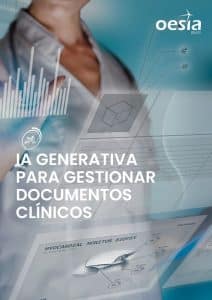
Introduction
In the field of health careThe recording of patients’ health information in complete and accurate clinical documents is essential for making sound medical decisions, optimizing the continuity of care by multidisciplinary healthcare teams, increasing the quality of services provided and improving patient satisfaction. However, the process of recording all patient information can be overwhelming and consume a significant amount of healthcare professionals’ time. This is where generative artificial intelligence (GAI) comes into play, a technology that is revolutionizing the way clinical documents are created and managed. In this article, we will explore how IAG is transforming the healthcare industry by streamlining and improving clinical document generation.
What is Generative Artificial Intelligence?
Generative artificial intelligence, also known as GAN (Generative Adversarial Network), is a technology that relies on deep learning and automation to generate new and original content from input data. In the healthcare context, GANs can be used for automated and accurate creation of clinical documents, diagnostic study reports, nursing notes and more.
Advantages of IAG in the Generation of Clinical Documents
- Efficiency: Traditional clinical document generation can be time-consuming and is particularly vulnerable to human error. IAG automates this process, drastically reducing the time required to create accurate and complete documents.
- Consistency: The IAG ensures consistency in the writing of clinical documents, which is essential for the understanding and interpretation of clinical information for decision making in the follow-up and continuity of patient care over time.
- Customization: Although the IAG generates documents in an automated manner, it can be adapted to reflect the preferences and writing styles of each type of healthcare professional: physicians, specialists, nurses, dentists, nutritionists, physiatrists, among others, ensuring that the documents generated are consistent with clinical practice.
- Error reduction: The production of incomplete, difficult to interpret and inaccurate clinical documents is a widespread problem worldwide. By eliminating human errors in documentation, such as typographical errors or errors of omission, IAG improves the quality and integrity of medical records. It is well known that this point is of fundamental interest for those healthcare institutions seeking quality and patient safety accreditations.
- Managing large volumes of data: IAG is capable of handling large amounts of medical data efficiently, which is critical in an ever-evolving healthcare environment where information is not deleted, but accumulated.
Applications in Clinical Practice
IAG is not only used to generate clinical documents, but is also being implemented in other areas of healthcare:
- Assisted diagnosis: Helps physicians interpret medical images, such as Rx, CT, MRI, pathology preparations and endoscopy images; providing more accurate and faster analysis, positively impacting productivity, assertiveness and enhancing the diagnostic skills of professionals.
- Treatment recommendations: Uses medical data to suggest treatment plans based on available evidence and clinical practice guidelines for the specialty.
- Medical research: Facilitates the generation of scientific research reports and abstracts, accelerating the advancement of medical knowledge.
Ethical Challenges and Considerations
Despite its advantages, the implementation of IAG in the generation of clinical documents poses ethical and safety challenges.
Privacy of patient data and protection against potential bias are important concerns that must be adequately addressed.
As WHO Director Dr. Tedros Adhanom Ghebreyesus has said, “any new technology, artificial intelligence offers great potential to improve the health of millions of people around the world; however, like any technology, it can also be misused and cause harm.”
It is essential that those of us who are dedicated to the design and development of tools that can influence the perception of healthcare professionals in making clinical decisions about their patients consider the clinical validation processes of the solutions we propose, as well as the traditional values of the professional practice of medicine: Primun non nocere (First do no harm).
Conclusions on generative artificial intelligence
Generative artificial intelligence is transforming the way clinical documents are produced and managed in healthcare.
By improving the efficiency, consistency and quality of medical documentation, the IAG is paving the way for more effective, patient-centered care. However, it is crucial to address ethical and safety challenges to ensure that this technology benefits everyone involved in healthcare.
The IAG promises an exciting future for healthcare, where healthcare professionals will be able to focus on what matters most to us: patient care and less on registration processes. Furthermore, the potential beneficial impact on care team communication ensures a continuity of care that will undoubtedly improve both the quality of services provided and patient satisfaction.
No technology can replace our role in people’s healthcare. But, definitely, this type of technology enhances our skills and boosts our quality as healthcare workers.
María Fernanda Aguirre, Medical Specialist in Digital Health KAM in Grupo Oesía
